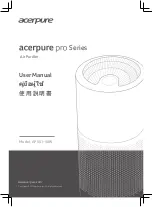
55
Sequence Of Operation
Mechanical Cooling Sequence Of Operation
Time delays are built into the controls to increase reliability
and performance by protecting the compressors and maxi-
mizing unit efficiency.
Units without an Economizer
For 27.5 through 35 Ton units, when mechanical cooling is
required, the RTRM energizes the Compressor Contactor
(CC1) coil. When the CC1 contacts close, the Compressor
CPR1 and Outdoor Fan Motor (ODM1) will start providing
the 3 minute "off" time has elapsed. ODM2 and ODM3
cycles off/on based on the outdoor ambient temperature as
measured by the Outdoor Air Sensor (OAS). CPR1 cycles off
as required providing the 3 minute "on" time has elapsed.
With CPR1 operating for a minimum of 3 minutes. If addi-
tional cooling is required, the RTRM energizes the 2nd
compressor contactor (CC2) to bring on CPR2. While CPR1
continues to run, CPR2 cycles on/off as needed to meet the
cooling requirements.
For 40 and 50 Ton constant volume and variable air volume
applications, once CPR1 has operated for a minimum of 3
minutes, and additional cooling is required, the RTRM
cycles CPR1 off and energizes compressor contactors CC2
and CC3 simultaneously. If additional cooling is required,
the RTRM energizes compressor contactor (CC1) providing
CPR1 has been off for a minimum of 3 minutes. This con-
figuration allow the dual circuit unit to operate with three
steps of cooling if CPR1 is the lead compressor.
If the indoor Fan selection switch is set to the “AUTO” posi-
tion on constant volume applications, the RTRM energizes
the Indoor Fan Contactor (F) coil approximately one second
after energizing first stage compressor contactor (CC1).
When the cooling cycle is complete and CC1 is de-ener-
gized, the RTRM keeps the Fan on for approximately 60
seconds to enhance unit efficiency. On variable air volume
applications, the Fan operates continuously.
Economizer operation based on Dry Bulb
Standard economizer dry bulb change over has four field se-
lectable temperatures (55, 60, 65, and 70
o
F). Refer to Table
14 for the proper potentiometer setting for each temperature
selection.
The economizer option allows cooling utilizing outdoor air
when the temperature is below the specified dry bulb set-
point (60° ±2° F factory setting). The air is drawn into the unit
through modulating dampers. The ECA modulates the
economizer dampers from minimum position to full open
based on a 1.5° F control point below either the space tem-
perature setpoint for constant volume applications or 1.5° F
around the supply air temperature setpoint for variable air
volume applications.
If the Mixed Supply Air Sensor (MAS) senses that supply air
temperature is too cold, the dampers are held in their cur-
rent position until the supply air temperature rises, or begin
to modulate toward the minimum position if the supply air
temperature continues to drop.
The economizer control allows fully integrated cooling op-
eration between the compressor(s) and the economizer
when needed to satisfy the cooling setpoint. The RTRM will
not allow a compressor to operate until the economizer
dampers have been fully open for at least three minutes.
The RTRM evaluates the rate of temperature change during
this delay and will energize compressor(s) as needed to
maintain temperatures within setpoint deadbands.
If a power exhaust option is installed, the exhaust fan(s) is
energized whenever the economizer dampers are at a posi-
tion greater than the exhaust fan setpoint.
Economizer operation based on Reference Enthalpy
Reference enthalpy is accomplished by using an Outdoor
Humidity Sensor (OHS). The reference enthalpy is field se-
lectable to one of four standard enthalpies. Refer to Table 14
for the proper potentiometer setting for each enthalpy selec-
tion.
If the outdoor air enthalpy is greater than the selected refer-
ence enthalpy, the economizer will not operate and the
damper will not open past the minimum position setting.
If the outdoor air enthalpy is less than the reference en-
thalpy, the dampers will modulate to maintain a 45° to 55° F
minimum supply air temperature (constant volume or vari-
able air volume applications). The ECA modulates the
economizer dampers from minimum position to fully open
based on a 1.5° F control point below either the space tem-
perature setpoint for constant volume applications or 1.5° F
below the discharge air temperature setpoint for variable air
volume applications. With reference enthalpy control, refer-
ence enthalpy is not allowed if the outdoor temperature is
below 32° F. Below 32° F, dry bulb economizer control is en-
abled.
If communications between the Outdoor Humidity Sensor
(OHS) and the Economizer Actuator Control (ECA) were to
fail, the economizer will operate using the dry bulb param-
eters.
Table 26
Humidity versus Current Input
Содержание Voyager RT-SVX17C-EN
Страница 8: ...8 Figure 1 Unit Dimensions for TC_ TE_ and YC_330 360 and 420 MBH Units Low Heat ...
Страница 9: ...9 Figure 1 continued Unit Dimensions for YC_330 360 and 420 MBH Units High Heat ...
Страница 10: ...10 Figure 1 continued Unit Dimensions for TC_ TE_ and YC_480 and 600 MBH Units Low High Heat ...
Страница 24: ...24 Figure 10 Typical FieldWiring Requirements for CV Control Options ...
Страница 78: ......
Страница 79: ......
Страница 80: ......
















































